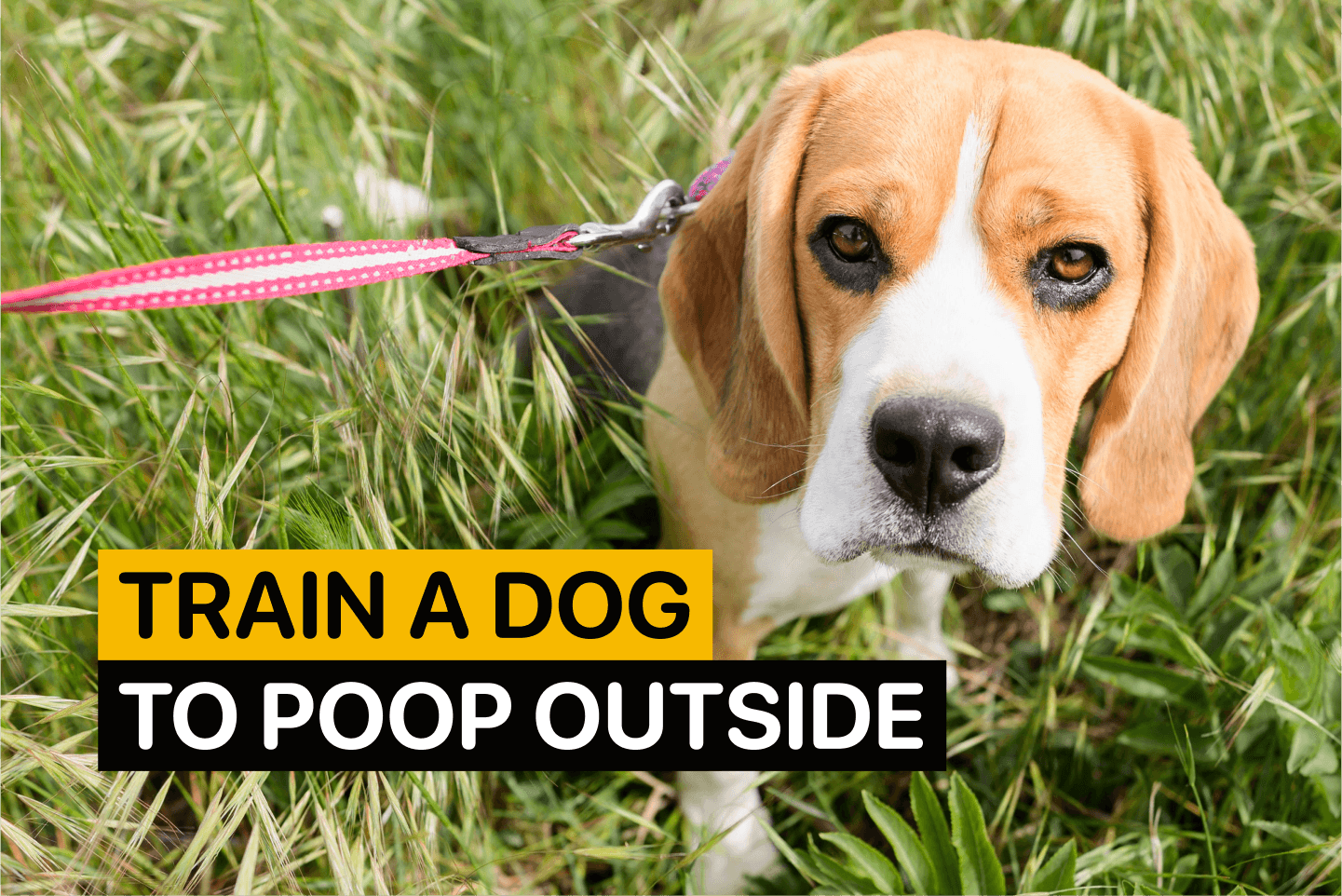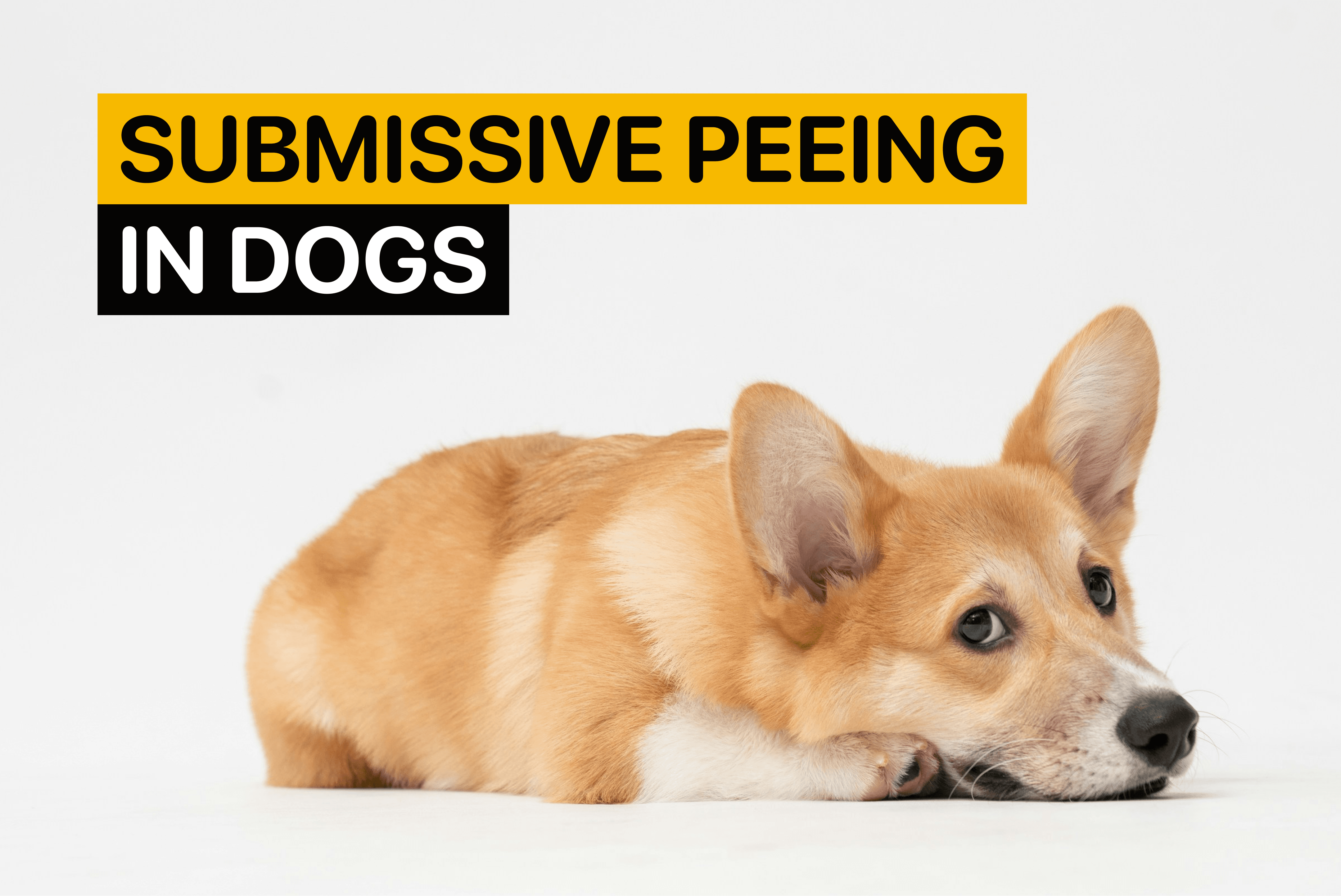Puppy Not Peeing Outside: What to Do and How to Teach?

By
Woofz Team Updated on |Reviewed by Frederica Caneiro
Even if your pup seems like a grown-up dog but still does their business inside your home, don’t worry; it’s normal! A dog's not expected to have complete control over their bladder until they're 12 months old.
However, it doesn’t mean you should ignore this behavior and wait for them to grow older. You still need to train a puppy to pee outside, as they don’t instinctively know that.
In this article, we will share some tips on how you can efficiently train a puppy to pee outside.
Reasons Why a Dog Won’t Pee Outside
Most owners find it easy to teach their dogs to pee outside. However, sometimes, the situation gets challenging if a pet refuses to pee outside, regardless of your best efforts to train them. The key to tackling the issue is defining why your furry companion stays adamant about doing their business outside.
Medical conditions
UTIs, bladder or kidney issues can cause pain and make your dog withhold while walking.
Behavioral factors
- Lack of potty training (the dog doesn't have the opportunity to go to the correct place whenever they need, or they haven't understood yet where they're supposed to do it, as they weren't adequately reinforced for doing it in the proper place).
- Previous negative experience of potty breaks (the dog was punished for doing in the wrong place, which they understood as "I shouldn't pee in front of them", resulting in withholding while the owner is around).
- Fear/anxiety in the environment (the dog is uncomfortable outside and waits until they reach their safe place to do it).

- The dog wasn't desensitized to the leash/harness. The owner takes them out at inappropriate schedules (if the dog is not capable of withholding, the owner needs to take them out when they need, instead of creating a fixed schedule that is not paired with this individual's needs.
Change of environment
Moving to a new area can be stressful for a dog, so they may not be comfortable going potty in unfamiliar surroundings.
Puppy Won't Pee Outside: Signs Your Dog Is Struggling to Pee Outside
It is not always possible to indicate whether the dog peed during a walk. Still, some signs of withholding are noticeable, so an attentive owner can determine if the potty break was effective. These signs indicate a medical condition, so a vet consultation is advised.
Watch out for these signs of urine withholding:
- Frequent accidents in potty-trained dogs (pups that for at least 3 months don't have accidents inside)
- Pacing, whining and other signs of discomfort
- Anxiety over outdoor potty breaks (whining or barking, restless behavior outside)
- Reluctance to go outside
How to Train a Puppy to Pee Outside: Step-by-Step Guide
1. Take your pup outside every hour
In the initial days at home, you may need to take your dog out for their “business” once every hour until they learn the correct behavior.

If you can't stay with your pup for extended periods, try taking them out immediately upon returning home and providing puppy pads in their confinement area for them to use for potty breaks.
Pro tip: Remove any carpets you may have in that space. Although teaching the dog to pee in the pad and outside at the same time is not the best option (they may get confused), it's better to have an appropriate place for peeing inside than to wait until they're able to hold for the long periods you're out.
For the first 10 times, you can reward your pet when they use a potty pad, then ignore the process.
If you see your dog going/starting to pee in the wrong place (sniffing and circling, restlessness or pacing, squatting or posturing), try to react as quickly as possible and bring them to the pad or move a pad to it. If they have any accidents inside, restart reinforcing the dog for using the potty pad. If your little rebel keeps destroying their pads, try a pad holder.

When you catch your furry friend in the act, say "No" and redirect them to their toys and chews. If they persist in this behavior, it's likely due to excess energy, indicating that additional training, walks and mental activity are needed.
2. Give them time to choose a perfect spot
Puppies often prefer to pee in areas with familiar textures. If your dog is accustomed to pee pads, consider taking one outside to reinforce the idea that it's an acceptable spot.

Additionally, seek out tranquil environments, such as places where other dogs have relieved themselves, green and less crowded areas, to encourage your puppy to do the same.
When walking your puppy, opt for a medium to long leash rather than a short one, ensuring they feel secure and comfortable. It's best to get them used to the leash at home before venturing out.
Keep your puppy on a leash to guide their exploration and prevent distractions. Encourage them to sniff around different areas and watch for signs such as circling or sniffing, which indicate they're ready to go.
Praise and reward them when they finally do their business. Once you know your pup’s favorite spot, it becomes much easier for them to pee and poo outside.
The Woofz app can help you with that.
3. Avoid going home immediately after your dog pees outside
We understand you may be in a hurry for work or other plans. However, if you drag your pooch back home immediately after peeing outside, you’re risking making them think it’s a punishment, so they will start doing their business only inside the house.
Instead, walk for at least 15 minutes more to create positive associations.
4. Use a confinement area to limit their access
Crate-training your pup or teaching them to stay alone in a separate room is an effective way to limit the area where they might have accidents and prevent damage to precious items.

Ensure your pup has their designated area with all the essentials, including water, food, toys, chews, a bed, and potty pads. Encourage them to spend time there alone occasionally.
Start by spending some time there with them (playing, training, or giving them an enrichment toy) to ensure they see it as a secure place, then leave them there for a few minutes while they're entertained with some mental activity and gradually increase the duration. It's expected that with the proper introduction, the dog doesn't whine or cry.
Also, consider reducing the time they're alone and enriching the confinement area with more chew bones, mental stimulation toys, etc. Eventually, your furry friend will learn to entertain.
5. Handle potty accidents properly
If your dog goes pee in the wrong place, gently interrupt them, then guide them outside (or to a pad if it's nearby), rewarding them for proper behavior.
If accidents occur at home, promptly clean up (preferably with an enzyme cleaner) and focus on prevention for next time to create a happy, accident-free environment.
6. Learn your pup’s potty schedule
Generally, all puppies need to go to the toilet after waking up from a nap, eating, drinking, or even having a short but intense playtime session. Observe your pooch to find out when exactly they need to go. Taking your furry friend out at the right moment increases your chances of success.
How Long Does It Take to Train a Dog to Pee Outside?
If a puppy begins outdoor potty training at 2 months old, and you're consistent with the training, you can expect them to be fully potty trained between 6 and 10 months old. However, the timeframe may vary depending on the dog, the environment, and the training approach.
Overexcitement, Territorial Marking, Incontinence
Overexcitement, territorial marking, and incontinence can also be reasons why your pup keeps peeing inside the house. Overexcitement is the most common, so let’s find out what you can do about it.
Overexcitement
Like human toddlers, pets may have accidents when they get overly excited. To address this, focus on teaching your pet to calm down by maintaining a relaxed atmosphere at home.

Encourage outdoor playtime during walks to channel excitement appropriately. Lastly, be patient; solving this issue takes time and consistent training. With patience and dedication, you can help your pet overcome excitement-induced accidents.
Territorial marking
Territorial marking often stems from your pet feeling insecure, especially during significant changes like having a new baby, getting another pet, or relocating. They want to assert ownership of their territory in response to these upheavals.
To address this behavior, consider the following:
- Avoid exposing your dog to items they may perceive as their territory and so want to mark
- Encourage frequent urination in appropriate locations
- Use an enzyme cleaner to thoroughly clean marked areas
- If you catch your pet in the act, firmly say "No," then guide them to the correct spot to finish. Praise and reward them for doing so.
Neutering may help reduce territorial marking, but it may not resolve the issue if other animals enter your home.
Incontinence
This is rarely a puppy issue, but it’s still best to be aware of it. The most apparent symptom is dribbling urine when the puppy is relaxed (lying or sleeping), walking, or urinating.

Incontinence in dogs often signals underlying health issues rather than emotional distress. Reasons could vary from UTI infections to spinal injuries or congenital disorders. Some dogs may suffer from temporary incontinence after being neutered.
To manage, consider these tips to ensure your pet’s comfort until a vet can be involved:
- Provide ample bedding and change it regularly
- Increase outdoor bathroom breaks
- Avoid scolding
- Use puppy diapers temporarily and maintain hygiene
Why doesn't my dog pee outside after a walk?
This might happen. Especially with young puppy, they feel more secure about doing that at home.
If that’s your case, try this:
- Go for a walk like you usually do.
- Return home if your furry friend is tired after a 30-minute walk but hasn’t done their business.
- After you arrive, watch your dog. If you see any signs they want to toilet (like sniffing and circling, restlessness or pacing, squatting or posturing), pick them up immediately, walk for 3 minutes with them in your arms, and go out again.
- Give them lots of praise and reward if they finally do it outside.
If your puppy is already too big to pick up, try to understand why they feel insecure when outside and desensitize them to that fear or simply choose another place to walk them.
Even if you don’t manage to do it in time or are too tired to go with them one more time after every walk, it’s okay, they’ll still learn to do it outside. It’ll just take a bit longer.
Final Thoughts
Mastering potty training with your furry friend isn't always a walk in the park! It requires time, patience, and tolerance for the occasional mishap. If you need extra support, don't hesitate to turn to the Woofz app for expert advice or a session with one of our certified trainers. With a bit of help, your dog will be a pro soon!


